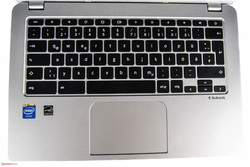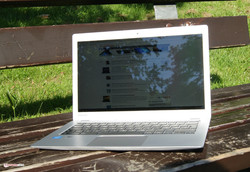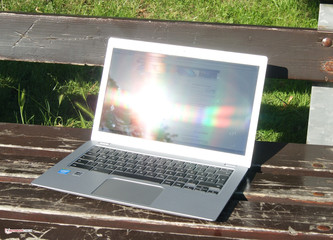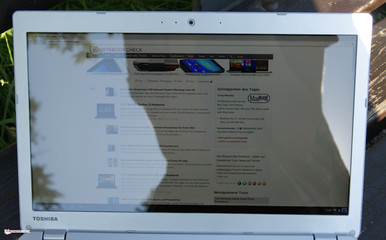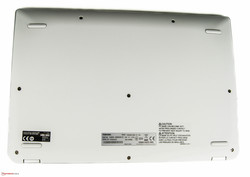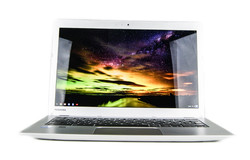Toshiba Chromebook 2 CB30-B Review

For the original German review, see here.
Toshiba's Chromebooks are going into the second round. We could closely examine Toshiba's CB lineup for the first time last year. This year, the manufacturer introduces two different laptops based on Chrome OS. In the report, we would like to concentrate on the stronger model. In addition to the more potent BayTrail M CPU and a larger 4 GB working memory, a high-quality, Full HD, IPS screen immediately catches the eye.
To put the review sample in perspective, we will continually use Chromebooks from other manufacturers for comparison. Our review sample is listed at a price of 380 Euros (~$422) although the starting price of this lineup is around 270 Euros (~$300). However, the buyer will have to waive some configuration features in return.
Case & Connectivity
The low-priced Chromebook presents itself in a matte-silver plastic casing. Its feel is pleasing thanks to the rounded corners and seamlessly joined casing components. There are shortcomings in the build despite that. The gap between the base unit and display is much higher in the center than at the edges in a closed state. Furthermore, the keyboard unit and display back can be dented effortlessly. The hinges allow opening the screen without stops and very smoothly. We cannot say how well the hinges will last over prolonged use though. It is quite easy to let the display rock. The display's back, just like the base plate, have a roughened texture that provides Toshiba's CB30 with enough grip for transportation. Its weight of approximately 1.3 kg (~2.9 pounds) makes the 13.3-inch laptop a convenient companion. However, the laptop should be secured for transportation because the choice of materials does not make an extremely rigid impression.
Eight screws that secure the base plate are found on the Chromebook's underside. We regrettably cannot say what maintenance options will be discovered here. There are no levers or other opening mechanisms. We had to abort our opening attempts to prevent damaging the shop sample.
Our review sample's diversity of interfaces generally corresponds to the essentials, which is typical for Chromebooks. Unfortunately, the review sample only sports one USB 3.0 port. The positioning strategy is, however, good. All important interfaces are on the left and right rear, and thus connected peripherals will not disturb the workplace.
Input Devices
Keyboard
The installed black chiclet keyboard has enough grip thanks to the roughened keys. Their pressure point is throughout homogeneous, and the keys do not yield too strongly in the corners. Unfortunately, it lacks drop and feedback. It is extremely soft and touch typists will experience a spongy typing sensation. This input device is suitable for brief typing and browsing sessions. The keys feature a standard size. Toshiba regrettably installs an unlit keyboard unit.
Touchpad
The lightly roughened surface convinces with its good gliding properties. Its size of 10.3 x 6.9 mm (~0.41 x 0.27 in) is also ideal for the little Chromebook. Furthermore, finger inputs are always smooth and effortless to perform. Like most touchpads, the problem zones are found in the corners. The input device unfortunately barely responds here. Another point of criticism is that the touchpad is deeper in the front area than toward the keyboard. The drop of the incorporated keys is very long at the edges and decreases clearly toward the center. Multi-touch gestures, such as scrolling websites, are always possible.
Display
From a technical point of view only, the manufacturer has done everything right with the screen. The installed screen has a Full HD resolution of 1920x1080 pixels. In view of a purchase price of just 380 Euros (~$422) we praise Toshiba’s opting for a high-quality IPS screen. The only option that is not available is the choice of a matte screen. While there is no matte screen option to reduce glare, the high average brightness of 374 cd/m² is more than sufficient when working indoors.
However, buyers who insist on a matte screen could take a closer look at Acer's Chromebook 13 or consider the CB30-B-103 model also from Toshiba. Unfortunately, not only the reflections are absent in this model: The resolution is reduced to 1366x768 pixels, and the working memory is also halved. On the other hand, its price of 270 Euros (~$300) is considerably lower.
Seen just subjectively, the black tones of our present Full HD model look relatively rich although the black level of 0.5 cd/m² is high. The contrast of 756:1 is extremely good for the Chromebook category.
| |||||||||||||||||||||||||
Brightness Distribution: 94 %
Center on Battery: 378 cd/m²
Contrast: 756:1 (Black: 0.5 cd/m²)
| Toshiba CB30-B-104 HD Graphics (Bay Trail), N2840 | Dell Chromebook 11-3120 HD Graphics (Bay Trail), N2840, 16 GB eMMC Flash | Acer Chromebook 15 CB5-571-C9GR HD Graphics (Broadwell), 3205U | HP Chromebook 14 G1 HD Graphics (Haswell), 2955U | Lenovo N20 Chromebook HD Graphics (Bay Trail), N2830, 16 GB eMMC Flash | Samsung Chromebook XE500C12-K01US HD Graphics (Bay Trail), N2840, 16 GB eMMC Flash | Acer Chromebook 13 CB5-311-T0B2 GeForce ULP K1 (Tegra K1 Kepler GPU), K1, 32 GB eMMC Flash | |
|---|---|---|---|---|---|---|---|
| Screen | -33% | -15% | -19% | -16% | -33% | -24% | |
| Brightness middle (cd/m²) | 378 | 273 -28% | 245 -35% | 226 -40% | 271 -28% | 201.8 -47% | 252 -33% |
| Brightness (cd/m²) | 374 | 258 -31% | 248 -34% | 227 -39% | 269 -28% | 201 -46% | 242 -35% |
| Brightness Distribution (%) | 94 | 88 -6% | 87 -7% | 86 -9% | 92 -2% | 77 -18% | 91 -3% |
| Black Level * (cd/m²) | 0.5 | 0.75 -50% | 0.4 20% | 0.4 20% | 0.48 4% | 0.521 -4% | 0.55 -10% |
| Contrast (:1) | 756 | 364 -52% | 613 -19% | 565 -25% | 565 -25% | 387 -49% | 458 -39% |
| Colorchecker dE 2000 * | 11.11 | ||||||
| Greyscale dE 2000 * | 11.8 | ||||||
| Gamma | 2.04 108% | ||||||
| CCT | 14412 45% |
* ... smaller is better
We did not perform detailed measurements regarding the model's color reproduction. However, a glance during use is enough to see that white tones look somewhat reddish.
The lightweight Chromebook is predestined for mobile use. Although the brightness is usually sufficient indoors, it finds its limits outdoors. The glossy screen's brightness cannot compensate direct sunlight. Using it under overcast skies or in shadowy places is possible though.
Performance
The Chrome operating system does not utilize many performance-demanding background processes, and concentrates on Internet and office applications. That is also why the system requirements for Google's OS are kept low. Although Intel's Celeron processor is located in the lower performance sector, the smooth workflow is compelling. We had to open multiple tabs with sophisticated video contents simultaneously to force the Chromebook to its knees. The manufacturer only offers one alternative configuration in this lineup, which only has 2 GB rather than 4 GB of working memory. Furthermore, a matte HD screen is installed instead of the glossy Full HD screen. The buyer will not have to invest as much for this configuration; it is approximately 110 Euros (~$122) cheaper.
System Performance
The Chromebook consistently gives the impression that it is quick. The performance of Toshiba's CB 30 will not disappoint users who limit themselves to smaller office tasks, playing videos and Internet browsing. The various browser benchmarks also confirm this subjective evaluation. Overall, the review sample is on par with its rivals. However, the 15-inch Acer Chromebook CB5 exhibits considerably higher performance despite its similar price.
| WebXPRT 2015 - Overall (sort by value) | |
| Toshiba CB30-B-104 | |
| Dell Chromebook 11-3120 | |
| Samsung Chromebook XE500C12-K01US | |
* ... smaller is better
Storage Device
The Chromebook lineups from our previous tests already had the reputation of little storage capacity. Our present review sample also only has a 16 GB eMMC flash memory. Expanding the storage via an internal storage is not intended. More storage capacity is only possible by installing a slower SD memory. Since the user logs in to the Chrome OS via a normal Google account, office documents, for example, are saved in Google's own cloud storage.
Graphics Card
The integrated GPU is a common find on most tablets and netbooks. Its performance is located in the low-end range. It mainly supports the CPU and delivers important standards like DirectX 11 and Shader 5.0. The iGPU especially provides important codecs, such as MPEG2, H.264, VC1, MVC, and VP8. We could not use our benchmark programs because the preloaded operating system does not support DirectX 11. At least our review sample renders Full HD videos smoothly, and simple simultaneous browsing is still no problem.
Emissions & Energy Management
System Noise
Toshiba receives the full score in the noise emission section. The fan-less design ensures that the review sample is noiseless.
Temperature
Despite passive cooling, we observe that the Chromebook does not get too hot whether in idle or load states. We run a 1080p video and Octane 2.0 simultaneously to provoke the maximum heat development. We record a maximum rate of 41 °C (105.8 °F) here. The laptop can even be used in this rather unrealistic scenario on the thighs. Toshiba's CB30 mostly remains below 32 °C (89.6 °F) while idling. The hot spot of 37 °C (98.6 °F) is found in the rear.
(+) The maximum temperature on the upper side is 35.6 °C / 96 F, compared to the average of 33.1 °C / 92 F, ranging from 21.6 to 53.2 °C for the class Netbook.
(±) The bottom heats up to a maximum of 40.7 °C / 105 F, compared to the average of 36.6 °C / 98 F
(+) In idle usage, the average temperature for the upper side is 28.5 °C / 83 F, compared to the device average of 29.8 °C / 86 F.
(+) The palmrests and touchpad are cooler than skin temperature with a maximum of 29.2 °C / 84.6 F and are therefore cool to the touch.
(±) The average temperature of the palmrest area of similar devices was 29.3 °C / 84.7 F (+0.1 °C / 0.1 F).
Speakers
The volume of the installed speakers is compelling for the small 13.3-inch laptop. However, it completely lacks bass. The trebles are slightly too dominant. The speakers are sufficient for occasional YouTube videos. Nevertheless, external devices should be used for really enjoying music.
Power Consumption
The little 45-watt power supply can almost be called cute in view of its size. The cable diameter is also considerably lower than the standard, and thus a bit of caution is needed here. The power supply's output is sufficient for the Chromebook. The power consumption never exceeded 12 watts during our tests.
| Off / Standby | |
| Idle | |
| Load |
|
Key:
min: | |
Battery Runtime
According to the manufacturer's spec sheet, a battery life ranging from 30 minutes to 11 hours is possible. We ascertain the factual battery life via a real-world scenario, i.e. simulating Internet browsing using a medium brightness of 150 cd/m². The Chromebook switched to standby after approximately 7.5 hours. Although it is far remote from reaching the promised runtime, it should last a whole workday with adapted brightness or frequent office use. However, other Chromebook models last longer. The equally sized 13-inch Acer CB3 achieved a better result of 10 hours in our test.
| Battery Runtime - WiFi Websurfing (sort by value) | |
| Toshiba CB30-B-104 | |
| Dell Chromebook 11-3120 | |
| Acer Chromebook 15 CB5-571-C9GR | |
| HP Chromebook 14 G1 | |
| Samsung Chromebook XE500C12-K01US | |
Pros
Cons
Verdict
The manufacturer has successfully launched on the market a solid Chromebook in the form of the Toshiba CB30. We observed just as many positive as negative aspects throughout our tests. Starting with the casing, we can call the feel, the low weight and the non-slip surface good. Unfortunately, the build quality shows some flaws. The display is a high-quality, Full HD IPS screen with decent brightness. We can only criticize the reddish tint here. It is also regrettable that the matte alternative only features an HD screen. The 13.3-inch laptop is exactly in the midfield in terms of performance. The fan-less design scores and it does not produce annoying heat. We did not achieve the battery life specified by the manufacturer. Even if our determined 7.5 hours are not exactly short, other rivals score with a considerably longer runtime.
Although Toshiba has not reinvented the wheel, the CB30 will prove a good companion in browsing and office routine.
The price of just 380 Euros (~$422) should not be neglected, either. Potential contenders from the Windows World below 300 Euros (~$333) can be found in our continuously updated list of Top 10 Notebooks under 300 Euros (~$333).
Toshiba CB30-B-104
- 08/07/2015 v4 (old)
Nino Ricchizzi







